Local News
A taste of Limmud 2020
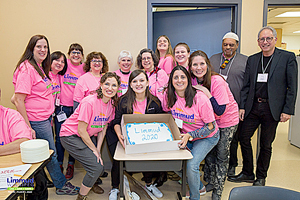
By MYRON LOVE
Limmud Winnipeg celebrated its tenth anniversary on the weekend of February 29/March 1 with quite possibly its best attendance to date. Close to 400 members of our community had more than three dozen sessions to choose from, with presenters from across Canada, New York and Israel joining local speakers and facilitators in providing a smorgasbord of topics both secular and religious, cultural and culinary.
As usual, this writer indulged in a representative sampling of what was on the menu, balancing local and Israeli issues with some religious study as well as delving into Jewish history. And, while each session could make for an entire feature on its own, space considerations leave me to focus on the highlights.
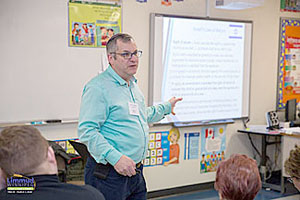
So let us begin the journey.
The first session that I attended was a presentation by former Winnipegger Jack Frohlich, who made a aliyah in 1989 and who, for the past 18 years, has been teaching conversion classes under the auspices of the National Centre for Conversion. He also works closely with the Beta Israel (Ethiopian) community.
Frohlich delivered two presentations – the first discussing the challenges facing Ethiopian Israelis and the second talking about the controversial issue of conversion in Israel. There is much misinformation concerning conversion in Israel, Frohlich pointed out.
My own understanding was that Reform and Conservative conversions are not recognized in Israel and – much to my surprise, there have been Orthodox conversions in North America that also aren’t recognized in Israel. The reality is that the only conversions officially recognized in Israel are those which are approved by the Dayanim (rabbi/judges) associated with the National Centre for Conversion.
As Frohlich noted, even a conversion by a rabbi in solidly Haredi Bnai Brak would not be recognized.
He pointed out that while Reform and Conservative conversions may not be recognized or the converts considered Jewish, they are still welcomed under the Law of Return with all the benefits that come with it.
Then there is the occasional report that converts have to vow to observe all the Mitzvot both during the conversion process and forever after on pain of having the conversion rescinded. Not true, Frohlich said. Once one is accepted into the Jewish community, the individual can life his or her life the same way those who are born Jewish do.
“Becoming a Jew is a two-sided coin,” he said. “It is a two-for-one deal. You are adopting a new religion and you become part of the Jewish People.”
While the original Law of Return applied only to Halachic Jews born of a Jewish mother, he noted, in 1970, the government expanded the Law of Return to include anyone with at least one Jewish grandparent – even though the individual would not be considered Jewish per se.
Of the Russian immigrants who came to Israel in the 1990s, Frohlich pointed out, about 50% were not halachically Jewish.
He reported that Israel registers about 2,500 conversions a year with most of the converts being women. “Weddings often follow,” he said.
Quite a number of Filipinos (Filipinas?) and Arab Moslems are among the converts, he noted.
And the government and the rabbinate continue to make the conversion process easier, he added. In recent years, all fees have been removed and a more flexible approach has been adopted for the learning process.
“Most students are pleasantly surprised by their ulpan/educational experiences,” Frohlich said.
He reported that about 80% of conversion applicants are approved the first time they appear before the Bet Din with the remainder often approved following a few more months of studying.
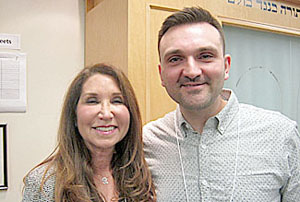
From Israel, we travel back to Winnipeg to hear the story of Shimon Segal. The 33-year-old criminal lawyer began life with the deck stacked against him. He has succeeded in life through his own inner strength and the love and support of David and Glenda Segal and their sons, Devin and Ryan.
Segal was born into a strictly Orthodox – but dysfunctional family. Over his first few years, he was imbued with Orthodox practice and tradition and a strong Jewish identity. The middle of three children, he recalls a lot of arguing in the home.
He began his schooling in the Hebrew Bilingual program at Centennial School in the North End. After Grade 2, he recalled, the family moved south, where his parents became less and less observant and opened a grow-op in their home. “The house was always moldy and dirty,” he remembered.
While attending Brock Corydon’s Hebrew Bilingual program, he made some friends among his classmates -, in particular, Devin Segal.
The Jewish Child and Family Service first stepped into the family situation when he was seven. He noted that his mother was abusive and his father disinterested.
When he was ten, his parents split and he found himself back in the North End in a group home where he was the only Jewish kid. “I was living a double life,” he recalled. “I was taking the bus to Brock Corydon every day. At the group home, I started smoking cigarettes and marijuana and wearing gang clothes to try to fit in. I would show up at school smelling of cigarettes. I didn’t fit in anywhere. While I remained close to my friends at Brock Corydon, most of their parents didn’t approve of their sons hanging out with me.”
The exception was David Segal. “My dad (David Segal) began to be involved in my life when I was ten,” Shimon said. “He took an interest in me. He would take me fishing sometimes. There was no sense of judgment. I relaxed when I was with him.”
For a short time, Segal was housed with foster parents Barry and the late Marsha Weber, to whom he is also grateful. The Webers took in foster children for short periods of time.)
At the age of 12, he was returned to his birth mother for a time. That didn’t work out. He spent some time in the Manitoba Youth Centre and with a Christian foster family who sent him to a bible camp. “They were only in it for the money,” he said of those foster parents.
“I began spending more and more time with the Segals,” Shimon said.
After several excruciating weeks with the Christian family, he was returned to his birth father who, after a short time, locked him out of the house.
That was when his life really took a turn for the worse. He ended up living on the street in Tuxedo. “I tried Osborne Village, but it felt too dangerous,” he recalled. “In Tuxedo, I felt safer. I slept wherever I could – partially-built buildings, a friend’s mother’s station wagon, even in the Assiniboine Forest for a time.”
It wasn’t long after that David and Glenda Segal invited him to move in with them permanently and become a member of the family. “David and Glenda became my dad and mom and Devin and Ryan my new brothers.”
He added that he has kept in touch with his own birth siblings – a brother and sister- and that the Segal family has included them in family gatherings.
The love and support from his new family, Shimon said, enabled him to rekindle his inner Jewishness and feel part of the Jewish community again.
Over the last ten years, Segal has been able to earn a law degree. He has married and become a father. And he has given back to the community and, through his legal work, other vulnerable people.
“Thanks to the Segal Family, I have been able to live a normal life,” he said.
“What the Segal Family did for Shimon was amazing,” said Randee Pollock, the Jewish Child and Family Service’s Adoption, Fostercare and Rescue Co-ordinator. “Our goal is to keep families together – but that is not always possible where there are mental health or addiction issues or perhaps there has been a death in the family.”
She reports that the JCFS currently has 15 Jewish children in care with nine foster homes and three places of safety available to house them. “We are always in need of more Jewish families who are willing to open their homes to children in our community who are in need of shelter,” she noted.
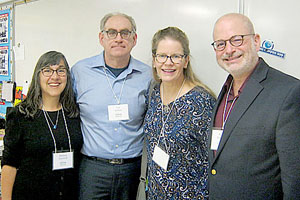
From Winnipeg, we again pack our bags for our third port of call as we follow Rabbi Mark Glickman, the spiritual leader of Reform Congregation Temple B’nai Tikvah in Calgary, as he travels the world in search of the lost story of the Cairo Genizah.
Glickman is the author of “Sacred Treasure – the Cairo Genizah: The Amazing Discoveries of Forgotten History in an Egyptian Synagogue Attic”. (He also delivered a talk at Limmud in 2016 about his follow-up book, “Stolen Words: The Nazi Plunder of Jewish books”.)
Glickman’s research took him to archives at Cambridge University and the Jewish Theological Seminary in New York – the world’s two largest repositories of Genizah documents – and, accompanied by his son, Jacob, to the Ben Ezra Synagogue in Cairo, which was the original repository of the Genizah.
So, you might be wondering what a “genizah” is? As Glickman pointed out, we are a People of the Book. Under Jewish Law, it is not allowed to throw out sacred books. The proper way to dispose of them is burial in a Jewish cemetery. But they have to be stored somewhere until they can be buried. In my own synagogue, the genizah – or storage space – is a cupboard downstairs. For many centuries in the old Ben Ezra Synagogue in Cairo, it was a space – a hole in the wall in the women’s section upstairs.
The current Ben Ezra Synagogue, Glickman reported, was built in the 11th century on the banks of the Nile, replacing an earlier shul which was destroyed by flooding. In the Middle Ages, he noted, Egypt was home to a large and influential Jewish community one of whose most prominent members was the great Rabbi Moses Ben Maimon (aka Maimonidies aka the Rambam).
There are a number of Western characters associated with the discovery of the treasure trove of documents that were stored in the Ben Ezra genizah. The first outsider to appear on the scene was one Simon Von Geldern, a German Jewish adventurer and Orientalist who moved in Bedouin circles. He visited the Genizah, but took nothing from it.
Then there came a Rabbi Jacob Saphir, a dealer in Jewish documents in Jerusalem, who heard about the Genizah from Van Geldern, dropped in, and brought back about 1,000 documents for sale. Next was Abraham Firkovitch, a member of the breakaway Karaite sect – who came in search of documents of historical interest to the Karaite community.
In the 1880s, Elkan Nathan Adler, a prominent member of England’s Jewish community – and son and brother of Chief Rabbis of England, visited and left with more than 6,000 documents (as possibly a Torah cover).
The scholarly interest in the Genizah, Glickman noted, began in 1996 when Rabbi Solomon Schechter – then teaching at Cambridge University, had an encounter with an unusual colleague. Twin sisters Agnes Smith Lewis and Margaret Dunlop Gibson were Semitic scholars and travellers who had recently returned from an expedition to St. Catherine’s Monastery at Mount Sinai. Among the documents they brought back was one in a language that the two multi linguists didn’t recognize. They asked Schechter if he could help. He recognized it as a tractate for the book Ben Sira, a book of wisdom that had not been included in the Talmudic canon. The book at that time was only known from a Greek translation.
“The last person to have seen that book in the original Hebrew was Saadia Gaon over 1000 years before,” Glickman noted. “The document was from the Ben Ezra Genizah. Schechter – very excited by this find – quickly arranged to visit the genizah and subsequently transferred close to 200,000 documents to Cambridge for translation and study.”
The documents – 300,000 in total – consisted not only of religious material but also letters, business records, medical prescriptions and the other detritus of every day life. Among the documents that Glickman highlighted was the oldest piece of Jewish sheet music (composed by an Italian Catholic priest who had converted to Judaism), an early Hebrew reading primer and the last letter that Maimonides received from his beloved younger brother, David, before the businessman was lost at sea en route to India.
Over the past 20 years, Glickman reported that advances in computer technology have made translating the documents and connected fragments much easier. He noted that the Freidberg Genizah Project was established in 1999 as a non-profit international humanities venture established by philanthropist Albert Friedberg of Toronto to promote and facilitate research of the material discovered in the Cairo Genizah. Under the aegis of the project, all of the genizah materials are in the process on being inventoried and put online.
Glickman completed his presentation with a video of himself peering into the now empty genizah.
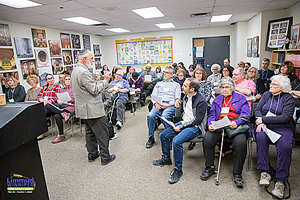
And we conclude with a little Torah study led by Rabbi Yosef Benarroch, spiritual leader of the Adas Yeshurun Herzlia Congregation. His question: Does being religious make you a better person?
In contemplating the question, Rabbi Benarroch first turned to the story of creation, noting that while the Lord commented after each of the first five days of creation that work was “good”, He does not say the same about His creation of mankind. Rather, the Torah says that the Lord “created Man in his image”.
So what does that mean? Benarroch quoted Torah and referred to several rabbanim – including Rabbi Akiva, Rambam and the late modern sages, Rabbis Joseph Soloveitchik and Abraham Joshua Heschel – as well as talmudic commentaries and their interpretations. One suggestion that Benarroch made is that of all G-d’s creations, man is the only one that can also create.
And while G-d doesn’t have an “image” in the way that man does, He does have attributes that can well be emulated – being slow to anger and quick to forgive, compassionate, gracious and merciful – attributes that are part of a prayer shul goers sing on Pesach, Shavuot and Sukkot before taking out the Torah and at Selichot in the days leading up to the High Holidays.
So, while engaging in regular religious practice itself doesn’t determine good or bad behavior, Rabbi Benarroch concluded, attempting to model your life after the qualities exhibited by the Lord – in His image – will, without a doubt make one a better person.
Local News
March of the Living 2023 participants form Taste of Hope project to help honour the memory of Holocaust survivor Alex Buckman

By BERNIE BELLAN The March of the Living is an annual two-week international educational program that brings thousands of students and adults to Poland and Israel to study the Holocaust, Jewish history, and the rise of the State of Israel. Founded in 1988, it features a 3-kilometer silent walk from Auschwitz to Birkenau on Yom HaShoah (Holocaust Remembrance Day).
Attendees on the march are accompanied by adults, some of whom themselves have been Holocaust survivors.
Following the week in Poland, participants travel to Israel to observe Yom HaZikaron (Israel’s Memorial Day) and celebrate Yom HaAtzmaut (Israel’s Independence Day), marking a journey from darkness to life.
For many years the coordinator of the march in Winnipeg was Roberta Malam, working on behalf of the Jewish Federation of Winnipeg. More recently Abby Flackman filled that role, and now the person in charge is Lindsey Kerr.
Since its inception 37 years ago the March of the Living has become a rite of passage for many young Winnipeg Jews who have been able to participate as an organized group from Winnipeg and combine visits to the death camp at Auschwitz-Birkenau in Poland with the subsequent trip to Israel.
Then – the Covid pandemic hit – in 2020, and the March of the Living was put on hold for two years – in 2020 and 2021.
In 2022, the March of the Living resumed, but there was no organized contingent from Winnipeg participating. (There may have been some Winnipeggers who did go on the march that year, but if there were any they would have been part of a general Canadian group since there was no Winnipeg coordinator that year.)
In 2023, however, once again a very large contingent of young Canadian Jews – 51 altogether, of whom approximately two-thirds were from Winnipeg, went on that year’s March of the Living. That particular march was memorable for many reasons, including the fact it was the last full march since 2019 and was to remain the last march to have an organized Winnipeg contingent in the past six years as the years 2024 and 2025 were interrupted by the war in Gaza. (There were smaller marches held in 2024 and 2025, but again there was no organized contingent from Winnipeg.)
Recently, we were contacted by one of the participants of that 2023 march, Ethan Levene, who asked us whether we’d be interested in running what turned out be a very poignant story about one particular aspect of that 2023 March of the Living.
Here is what Ethan wrote:
“In April 2023, the Coast to Coast Canadian delegation of March of the Living was privileged to travel with Holocaust survivor Alex Buckman (z”l). March of the Living is a Holocaust education trip that allows participants to visit and bear witness to the sites of the Holocaust. Unfortunately, while sharing his story in Poland, Alex passed away. However, the impact he left on us students was immeasurable.
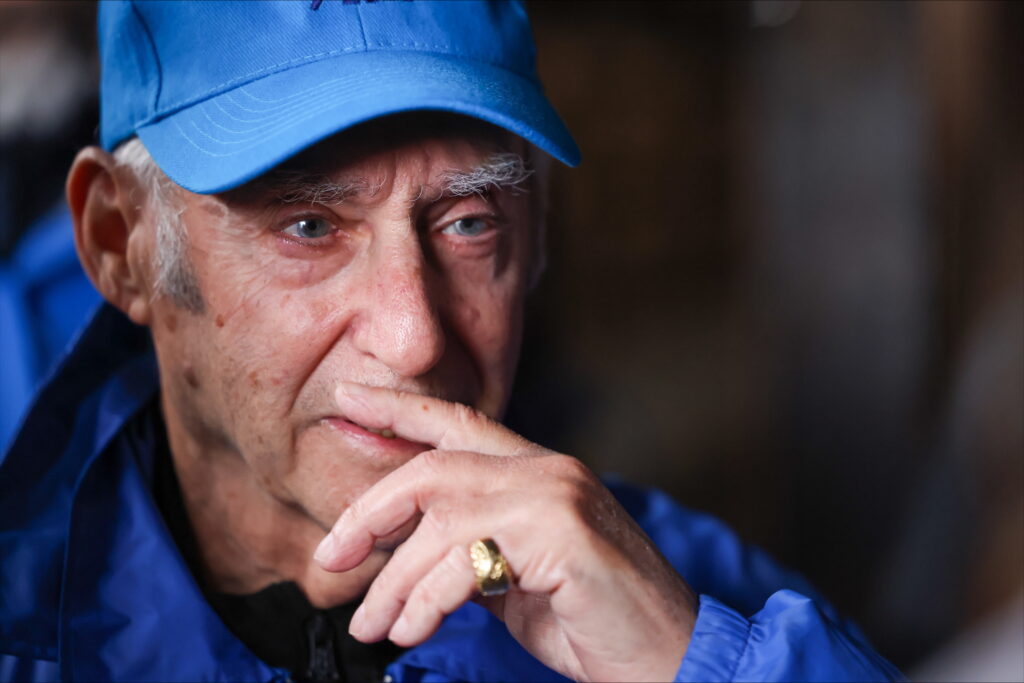
“While speaking to us in Warsaw, Alex told us the story of his Aunt Becky’s gâteau à l’orange (orange cake). While in Ravensbruck concentration camp, his aunt managed to write down this recipe. After his parents’ murder, his Aunt Becky went on to raise Alex after surviving. In addition to sharing his story, Alex tasked us with baking the cake with family and friends.
“Out of this, a group of alumni from our trip have created this project: ‘A Taste of Hope.’ On February 1st, university students from over 5 universities across Canada will come together to bake the gâteau à l’orange and hear Alex’s story. Proceeds from the event and this fundraising page will support the World Federation of Jewish Holocaust Survivors and Descendants. Alex was heavily involved with this organization, whose mission is to both create community for Holocaust survivors and their descendants and educate about the Holocaust to help fight against antisemitism and all forms of bigotry and hate.
“Here is information from our fundraising page for the event – ‘A Taste of Hope’: Fundraising for A Taste of Hope.
Ethan added that “it’s completely student led, all by alumni from our 2023 trip attending university at these various locations across Canada; Winnipeg, London, Kingston, Montreal.”
He also added: “Follow us on instagram@tastehope.“
Here is a link to a CBC story about Alex Buckman: Alex Buckman story
In a subsequent email Ethan gave the names of Winnipeggers who are involved in A Taste of Hope: Ethan Levene (studies at McGill), Zahra Slutchuk, Alex Stoller (studies at Queens), Coby Samphir, Izzy Silver (studies at Waterloo).
He also added names of others who are involved in the project: Jessie Ages, Anneke Goodwin, Lilah Silver, Ella Pertman, Ellie Vogel, and Talia Cherun.
To find out more about March of the Living in Winnipeg go to: March of the Living
Local News
Young Researcher Eryn Kirshenbaum 2025 recipient of the Institute of Cardiovascular Sciences prestigious Dr. T. Edward Cuddy Award
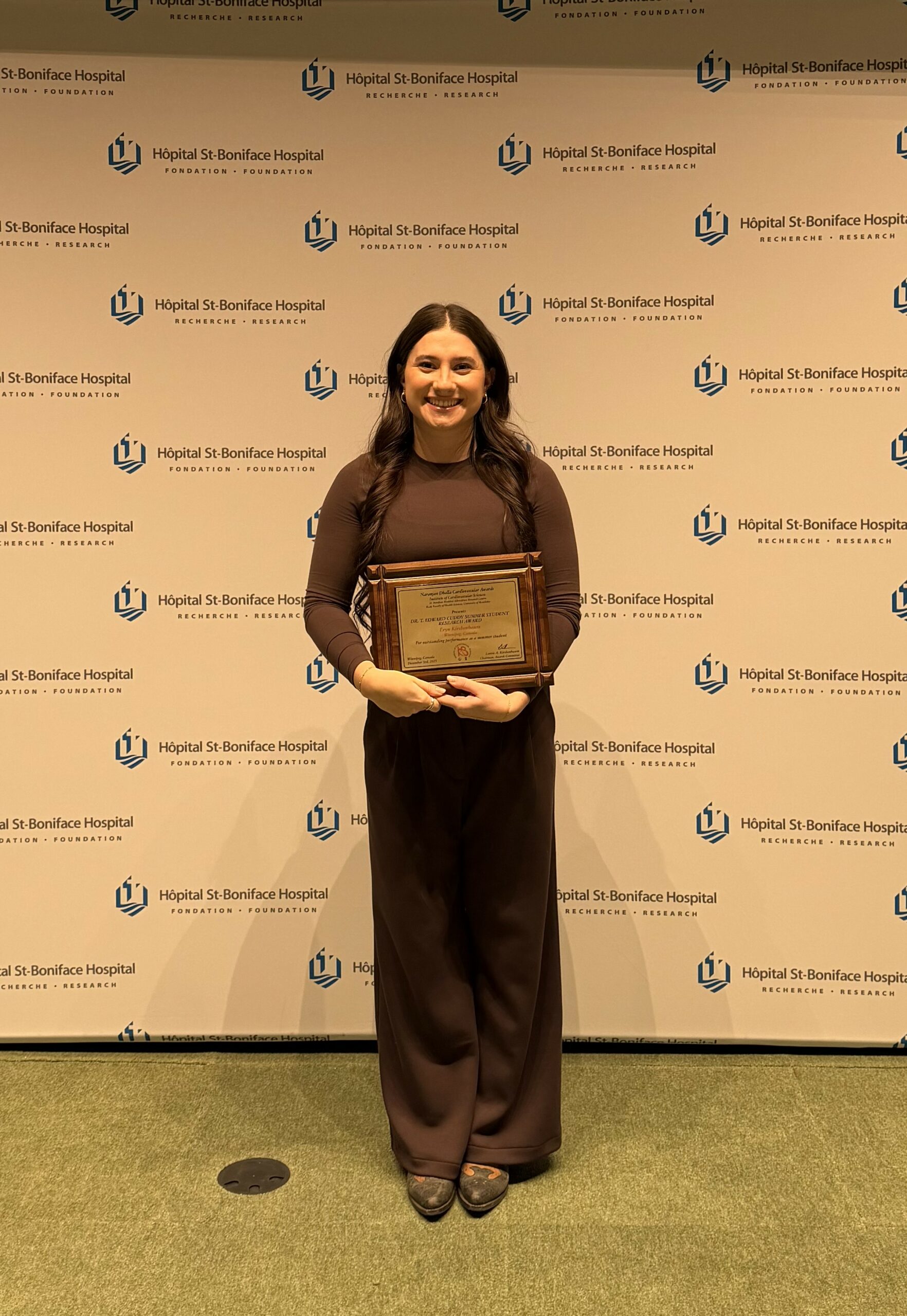
By MYRON LOVE Fifth year University of Manitoba Faculty of Sciences Microbiology student Eryn Kirshenbaum is this year’s recipient of the Dr. T. Edward Cuddy Student Award in recognition of her excellence in research under the supervision of Dr. Inna Rabinovich-Nikitin, Assistant Professor of Physiology and Pathophysiology, University of Manitoba and Principle Investigator in Women’s Heart Health Research at the Institute of Cardiovascular Sciences at the St. Boniface Hospital Albrechtsen Research Centre.
When asked for her reaction to learning she was the 2025 recipient of the student award, Kirshenbaum says “I was so honoured, humbled and excited to have been nominated and then chosen as the recipient out of many well deserving students.”
Rabinovich-Nikitin, Kirshenbaum’s mentor, says “This is Eryn’s third year working in my lab and I am incredibly proud of her for winning the Dr. T. Edward Cuddy Research Award.” She adds: “It is a truly deserved honour. Since joining my laboratory in 2023, Eryn has shown an exceptional combination of technical skill, intellectual curiosity, and professional maturity, becoming an integral contributor to our research on women’s heart health, an area of growing scientific importance that demands both rigorous methodology and a strong understanding of sex-based differences in heart disease.
“Not only has Eryn provided invaluable experimental support, but she has also taken on a leadership role in training new students and has demonstrated a strong commitment to collaboration and mentorship.”
In return, Kirshenbaum notes that she has “learned a lot from Dr. Rabinovich-Nikitin. She is a great mentor and I look forward to learning and growing even more under her leadership”.
The T. Edward Cuddy Award is one of 12 awards presented annually by the Institute of Cardiovascular Sciences in partnership with the University of Manitoba.
The 27th Annual Institute of Cardiovascular Naranjan Dhalla Awards were held on December 2nd and 3rd as part of a two-day conference comprised of a scientific forum and awards ceremony. The awards celebrate the leadership of individuals who have profoundly influenced the advancement of cardiovascular research, medicine and health education, including, in previous years, Nobel Prize winners and Gairdner Award Scholars. The Institute of Cardiovascular Sciences Gold Medal was awarded to Dr. Stanley Nattel, Director of the Montreal Heart Institute for his outstanding contributions to advancements in cardiac arrythmias and patient care.
Eryn Kirshenbaum, the daughter of Barry and Kim Kirshenbaum, says she was always interested in understanding the functioning’s of the human body, in particular the heart, which has fit with her desire to pursue a career in medicine and possibly continued heart health research.
A graduate of the Hebrew Bilingual program at Brock Corydon Elementary School, Ecole River Heights, and Kelvin High School French Immersion, Eryn says that she has always been interested in science, particularly cardiology. She reports that she has assisted as co-author on 5 research papers, including one where she was the primary author, focusing on women’s heart health and how heart disease affects women differently than men. That paper also investigated the connection between disrupted circadian rhythms and heart disease, specifically related to individuals with irregular sleep patterns, such as shift workers.
Eryn notes that, in addition to her university studies and research activities, she works part time as a Medical First Responder with St. John Ambulance – an activity which complements her medical research. “With St. John Ambulance, I have had calls dealing with the early stages of heart attacks and strokes as well as basic first aid,” she notes.
Readers might also run into Eryn at many Jewish celebrations such as Yom Ha’atzmaut, where she helps her dad with the family entertainment business.
While her ultimate goal, she says, is to practice medicine, she adds that she is really enjoying doing research.
Local News
Young entrepreneur Noah Palansky and partner Jordan Davis are the first Winnipeggers to crack Forbes Magazine’s “top 30 Under 30” list
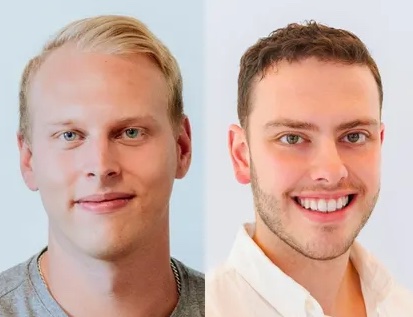
By MYRON LOVE From a very young age, Noah Palansky has demonstrated initiative and leadership. I first met and interviewed Palansky in 2011 at a low point in his life. His mother, Naomi Palansky, had sadly passed away at a young age. The then 12-year-old channeled his mourning into action. With his younger sister, Lexi, by his side – and the support of his father, Bruce – the preteen entered a team in the annual CancerCare Manitoba Foundation Challenge for Life. For the next few years, Palansky’s teams – under the banner, “Kids Count” – raised thousands of dollars for cancer researched.
Fast forward to 2019. Palansky was by then a young adult with a new initiative. The year before, he and a couple of friends had entered a potential business proposal in a competition sponsored by Winnipeg-based North Forge, Canada’s only start up incubator and fabrication lab, and won the top prize.
In that 2019 story, the young entrepreneur recalled how he came up with idea for his new business – TAIV (the AI stands for artificial intelligence). In the spring of 2018, he recounted, at the height of the Winnipeg Jets playoff run, he and his girlfriend were watching the game on a big screen while having drinks in a restaurant when an ad appeared onscreen promoting a rival restaurant and advertising the same drink he was imbibing – at a lower price.
“That ad gave me the germ of an idea,” he said in that earlier interview. “I immediately spoke to the restaurant manager and asked how he felt about the ad,” he recalls. “He was not pleased.”
That germ of an idea has developed into a highly successful new business venture. The idea that was put into practice has landed Palansky and his partner, Jordan Davis, on Forbes Magazine’s 30 Under 30 list in the Marketing and Advertising category. The duo are the first Winnipeg-based entrepreneurs to have received this honour.
“It came as a complete surprise,” Palansky responds. “We had no advance notice that we were even being considered for this recognition.”
Since TAIV officially launched in 2021, the company – still based in Winnipeg – has grown to a workforce of about 80 – most of whom are based here. Palansky notes that TAIV also has sales offices in New York, Chicago and Los Angeles.
In the past four years, TAIV has built a presence in nearly 5,000 venues across the United States. The company works with brands like Coke, Pepsi, Netflix, T-Mobile, FanDuel, Fox, and United Airlines.
“The way this works,” Palansky explained to this writer in 2019, “ is that if you are in Boston Pizza, for example, watching a Jets game and a commercial comes on, our software will switch the commercial to an ad for Boston Pizza.
“We make a little box that sits between your cable box and the TV. Our box can detect when a commercial is coming on and switch the ad out for one promoting the restaurant or store the box is in.”
For larger enterprises, Palansky notes, TAIV produces a web app that allows the company to switch its own in-house ads for the ads that would be appearing on screen.
In a statement by North Force celebrating Palansky and Davis’ achievement, Palansky is quoted as saying that “the Forbes achievement offered a rare moment to pause and reflect.
“There are very few moments where a third party reaches out and says, ‘We’ve noticed what you did, and we think it’s awesome.’ This felt like one of those rare moments.”
The North Forge report also sees the recognition as a win for the community.
“I wish we had more Winnipeg entrepreneurs on the global stage because it’s really good for the local ecosystem,” Palansky is quoted as saying. “I’m trying to do what I can to help others get off the ground.”
Palansky and Davis are looking forward to going to Phoenix in April for the official presentation.
He adds that TAIV continues expanding across North America, strengthening partnerships, and onboarding advertisers as the network grows. For local venues or businesses interested in installing TAIV or exploring advertising opportunities, the company welcomes inquiries at hello@taiv.tv.

